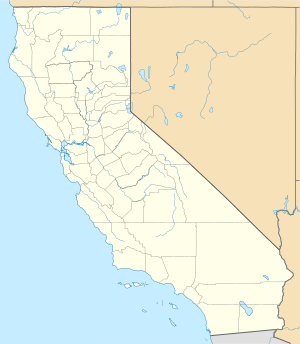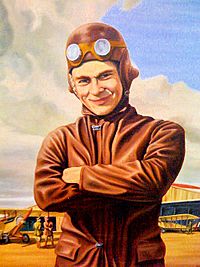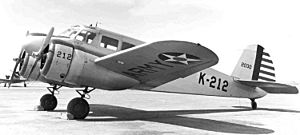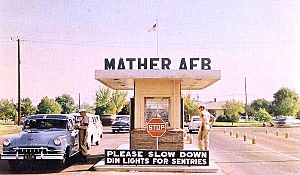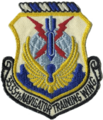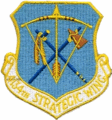Mather Air Force Base facts for kids
Quick facts for kids Mather Air Force Base
|
|
|---|---|
| Part of Air Training Command (ATC) | |
| Sacramento County, California | |
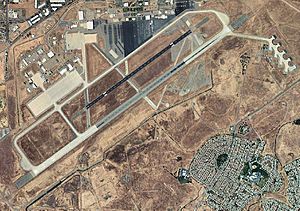
2006 USGS airphoto
|
|
| Coordinates | 38°33′14″N 121°17′51″W / 38.55389°N 121.29750°W |
| Type | Air Force Base |
| Site information | |
| Controlled by | United States Air Force |
| Site history | |
| Built | 1918 |
| In use | 1918–1993 |
| Battles/wars | World War I World War II |
| Garrison information | |
| Garrison | 323d Flying Training Wing |
Mather Air Force Base (Mather AFB) was a special place where the United States Air Force trained pilots and navigators. It was located about 12 miles (19 km) east of Sacramento, California. Mather AFB closed in 1993 after the Cold War ended.
Originally, it was called Mather Field and started in 1918. This was during World War I, when the United States needed many training camps for its Air Service. Today, parts of the old base are used for Sacramento Mather Airport. Some land also became part of the city of Rancho Cordova, California.
Contents
History of Mather Air Force Base
Mather Air Force Base was named after a brave pilot, Second Lieutenant Carl Spencer Mather. He was 25 years old and died in a training accident in 1918. Carl Mather had learned to fly at a young age and became an instructor. His classmates asked for the base to be named in his honor.
World War I: The Beginning
In January 1918, the Army looked for places to build aviation schools in California. They chose a spot near Sacramento called Mills Station. Construction began quickly, and Mills Field opened on April 30, 1918. It was a large area, covering over 700 acres, and could hold up to 1,000 people.
Training Pilots for War
Mather Field was a place for basic flight training. Pilots learned how to fly in planes like the Curtiss JN-4 Jenny. The training course lasted eight weeks. After finishing their basic training at Mather, pilots would go to another base for more advanced lessons.
Many pilots trained at Mather Field. When World War I ended in November 1918, the future of Mather Field was uncertain. Training activities stopped in November 1919.
Quiet Years: Between the Wars
After World War I, Mather Field was mostly closed in December 1919. Only a small group of people stayed to look after the base. The land was even leased to local farmers for a while.
However, Mather Field was reopened on April 1, 1930. It was used to help with aerial forest patrols. It became active again, but not as busy as it would be later.
World War II: A Busy Training Hub
Mather Field became a very important base again on May 13, 1941, as World War II began. The base grew much larger, from 872 acres to over 4,400 acres (17.8 km2).
In 1941, Mather Field became a key place for training navigators. Navigators are essential crew members who guide aircraft. The training was tough, lasting 18 weeks. Students learned how to find their way using stars and by calculating their position. They had to spend 100 hours navigating during flights. Later, the navigator school moved, and Mather became a place to train pilots for twin-engine bombers like the North American B-25 Mitchell.
Towards the end of the war, Mather also helped move troops and planes to the Pacific. Even the 509th Composite Group, famous for its role in the war, stopped at Mather before heading to the Pacific.
The Cold War Era
During the Cold War, Mather Air Force Base became the main school for training navigators for the United States Air Force (USAF). The base used special planes like the Convair T-29 and later the Boeing T-43A (which looked like a Boeing 737 passenger jet) for training.
Mather also started training navigators for the United States Navy and United States Marine Corps. These navigators would fly large planes like the Lockheed P-3 Orion. Later, smaller Cessna T-37 planes were added for Air Force students who would fly fast jets like the F-4 Phantom II.
Strategic Air Command
From 1958 to 1989, Mather AFB was home to the Strategic Air Command (SAC). SAC was a very important part of the Air Force during the Cold War. Its job was to deter attacks by having powerful bombers and refueling planes ready.
The base had B-52 Stratofortress bombers and KC-135 Stratotanker refueling planes. Some of these planes were always on alert, ready to take off in 15 minutes if needed. They also trained for bombing missions and air refueling.
The 940th Air Refueling Group, a reserve unit, also moved to Mather AFB in 1977. They flew KC-135 planes and later moved to other bases when Mather closed.
Closure of Mather Air Force Base
In 1993, Mather Air Force Base was officially closed. This decision was part of a plan to reorganize military bases after the Cold War. Most of the land was given to Sacramento County, California.
Today, the former base is used for several things:
- Sacramento Mather Airport, which is a public airport.
- Mather Regional Park, a place for outdoor activities.
- A Veterans Administration Medical Center, which helps military veterans.
- A facility for the Federal Aviation Administration (FAA) that controls air traffic.
- The Mather Community Campus, which helps people who need temporary housing.
Major Units at Mather AFB
Over its history, many important units were stationed at Mather Field and Mather Air Force Base. These units were responsible for training pilots, navigators, and other aircrew members. They also played a role in national defense, especially during the Cold War.
- 283d Aero Squadron (1918–1919)
- Army Air Corps Advanced Flying School (1941–1944)
- Army Air Force Navigation School (1943)
- USAF Navigator School (1946–1993)
- 3535th Navigator Training Wing (1948–1963)
- 4134th Strategic Wing (1958–1963)
- 320th Bombardment Wing (1963–1989)
- 323d Flying Training Wing (1973–1993)
- 940th Air Refueling Group (1977–1993)
Natural History at Mather
The land where Mather Air Force Base was built is special. It has rare wetland areas called vernal pools, which are unique to California. These pools are home to many different plants and animals.
The area is mostly grassland, and you can find many native grasses and wildflowers there. Some examples include the Yellow Mariposa Lily and the Vernal Pool Buttercup. The vernal pools also provide a home for rare plants like Ahart's Dwarf Rush and Boggs Lake hedgehyssop.
Images for kids



